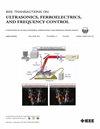Double Metal Dots Configuration for Suppression of Spurious Responses in Temperature Compensated Surface Acoustic Wave Resonators on SiO₂/LiNbO₃ Structure
IF 3.7
2区 工程技术
Q1 ACOUSTICS
IEEE transactions on ultrasonics, ferroelectrics, and frequency control
Pub Date : 2025-01-08
DOI:10.1109/TUFFC.2025.3526958
引用次数: 0
Abstract
This article proposes a double metal dots interdigital transducer (IDT) configuration for suppression of spurious responses in temperature-compensated surface acoustic wave (SAW) resonators employing the SiO2/LiNbO3 structure. The proposed IDT configuration includes primary metal dots at the edges of the IDT aperture region, and in addition, secondary metal dots placed near the busbars with the addition of short dummy electrodes. This double metal dots IDT configuration enables us to effectively suppress two kinds of spurious resonances: the transverse resonances that are common and the ones that are predominantly excited in the gap regions between IDT finger edges and busbars. The impact of geometric parameters on suppressing spurious responses is studied using periodic 3-D finite element simulations. Then, it is shown both theoretically and experimentally that the proposed mechanism can effectively suppress almost all spurious responses without affecting the critical performance metrics such as the quality factor and electromechanical coupling coefficient.双金属点结构对SiO2/LiNbO3结构表面声波谐振器杂散响应的抑制
本文提出了一种采用SiO2/LiNbO3结构的双金属点数字间换能器(IDT)结构,用于抑制温度补偿表面声波(SAW)谐振器中的杂散响应。所提出的IDT结构包括位于IDT孔径区域边缘的初级金属点,另外,放置在母线附近的次级金属点加上短假电极。这种双金属点IDT配置使我们能够有效地抑制两种杂散共振:常见的横向共振和主要在IDT手指边缘和母线之间的间隙区域激发的共振。利用周期性三维有限元模拟研究了几何参数对抑制杂散响应的影响。然后,理论和实验表明,该机制可以有效地抑制几乎所有的杂散响应,而不会影响质量因子和机电耦合系数等关键性能指标。
本文章由计算机程序翻译,如有差异,请以英文原文为准。
求助全文
约1分钟内获得全文
求助全文
来源期刊
CiteScore
7.70
自引率
16.70%
发文量
583
审稿时长
4.5 months
期刊介绍:
IEEE Transactions on Ultrasonics, Ferroelectrics and Frequency Control includes the theory, technology, materials, and applications relating to: (1) the generation, transmission, and detection of ultrasonic waves and related phenomena; (2) medical ultrasound, including hyperthermia, bioeffects, tissue characterization and imaging; (3) ferroelectric, piezoelectric, and piezomagnetic materials, including crystals, polycrystalline solids, films, polymers, and composites; (4) frequency control, timing and time distribution, including crystal oscillators and other means of classical frequency control, and atomic, molecular and laser frequency control standards. Areas of interest range from fundamental studies to the design and/or applications of devices and systems.

 求助内容:
求助内容: 应助结果提醒方式:
应助结果提醒方式:


